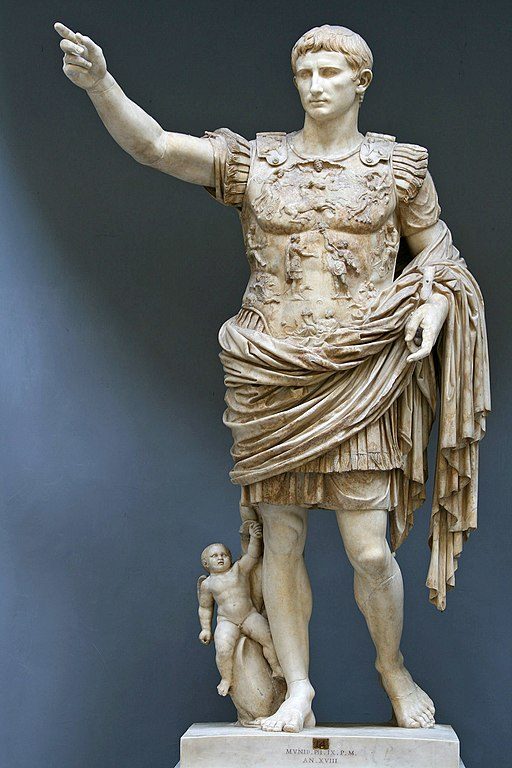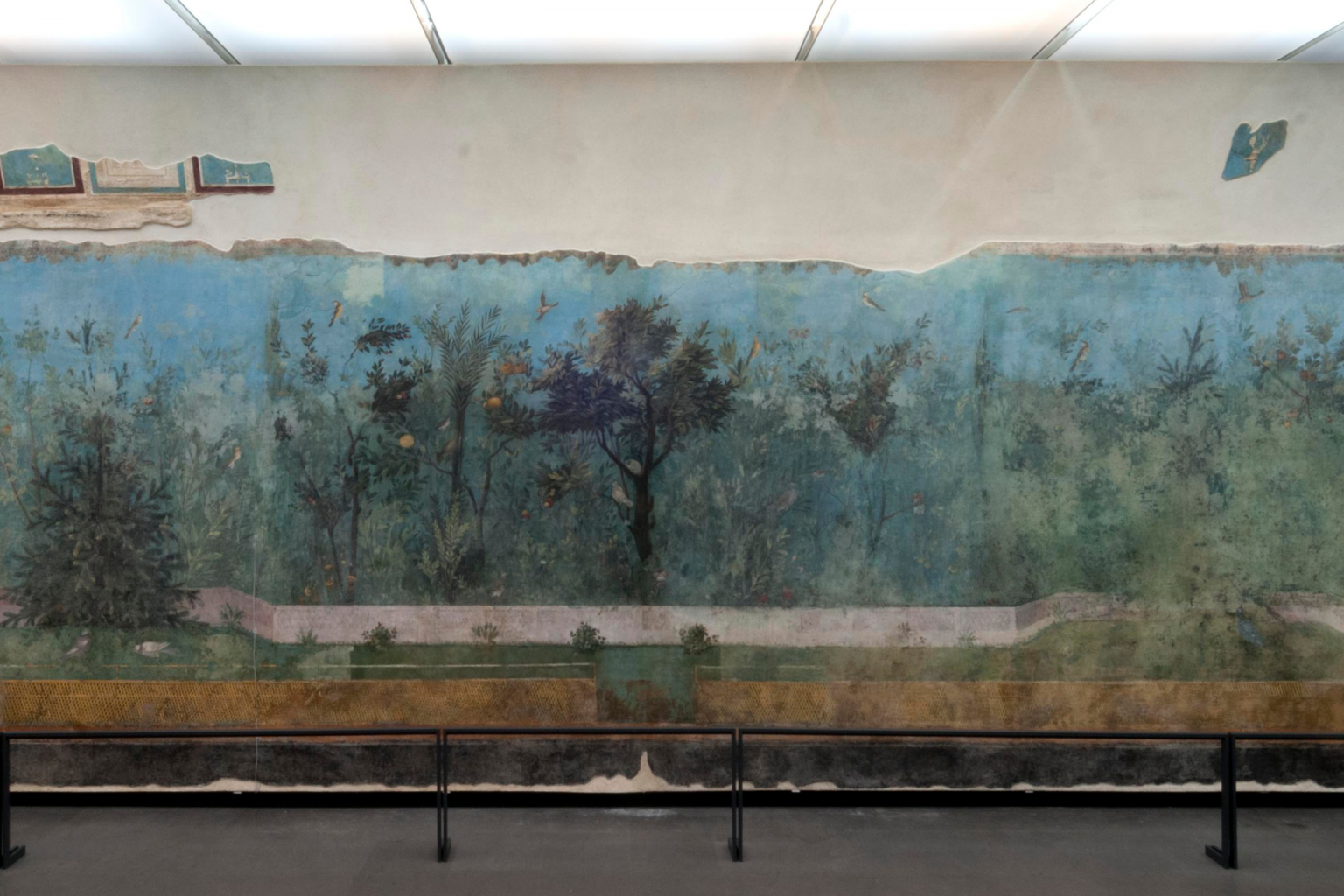
Rome’s antique frescoes. The painted garden from the Villa of Livia at Prima Porta
03.6.2024 von Valeria Intini, assistant curator at Museo Nazionale Romano
Augustus, Livia and the Golden Age of Rome
In late republican Rome, political instability stimulated the utopian expectation of a new era. Mark Antony and Cleopatra promised the return of the mythical Golden Age, as ever as the Alexandrian rulers had always done through the ideal of the universal empire and the symbols of the evergreen renewal of nature. The young Octavian, future Augustus, instead, sought the support of the traditionalist aristocracy and promised a return to the old purity under the patronage of Apollo.

Portrait of Livia Drusilla, end of the 1st cent. B.C. – beginning of the 1st cent. A.D., Museo Nazionale Romano, Crypta Balbi, Rome © Museo Nazionale Romano, photo: Luca Zizi
Prodigious stories then spread, about an eagle dropping a white hen with a laurel sprig in its beak onto the lap of newlywed Livia, while she was in her country villa at ninth mile of the Via Flaminia, on the hill overlooking the Tiber Valley. The branch of the plant sacred to Apollo would have become that laurel grove around the villa where the future Julio-Claudian emperors would have plucked the triumphal crowns. From this hen so many chicks were born that the villa was called Ad gallinas albas.
Livia Drusilla Claudia probably inherited the villa from her father in 42 BC (when he, following Cassius and Brutus, committed suicide). When in 39 BC she returned to Rome from exile in Greece, already mother of Tiberius from her first marriage, the young Octavian knew she was precisely the bride he needed to ally himself with the senatorial aristocracy. A year later, the marriage between Livia and Caesar’s heir recomposed the Roman society torn by a century of internal strife. For the next fifty years this couple would remain at the top of the nascent Roman Empire. A Livia’s common iconographic representation was in the guise of the goddess Ceres, dispenser of growth and next to the traditional feminine ideal of virtue.
Livia’s gardens
The imperial couple commissioned a large, terraced garden housing the laurel grove, that reshaped the topography. The visual impact of the villa in the landscape almost alluded to the architecture of a sanctuary, remembering the primeval purity of Rome and visualizing the sacral dimension of Augustus’ rule, while from above the imperial couple enjoyed the view of Rome framed by laurels. A semi-subterranean room was frescoed with the representation of a garden, presumably between 38 and 20 BC, as a visual rendering of the Augustan prosperity, illustrating the paradisiacal condition promised. The suggestive universal symbols connected to Mother Earth had to be inspired to Augustus particularly by his initiation into the Eleusinian Mysteries after the conquest of Egypt in 31 BC. Sun, Moon and the florid goddess Earth appear on the armor of the famous statue of Augustus of Prima Porta found in Livia’s Villa. In 17 BC, the poet Horace celebrated the new Golden Age inaugurated by Augustus, invocating Apollo and Diana as superintendents of the new saeculum. Later, on January 30, 9 BC, Livia’s birthday, the Ara Pacis (Altar of Augustan Peace) was dedicated, depicting the goddess Earth in all her fruitful splendor, in the pacified and orderly world like a garden.

Augustus of Prima Porta, 1st century AD, Vatican Museums, Vatican City © Wikimedia Commons, photo: Till Niermann
Archaeological excavations in the Villa of Livia
The excavations by the Soprintendenza Archeologica di Roma confirmed the dating to the Augustan phase of the garden with the laurel grove, delimited by a three-armed portico, continuing south into a fenestrated porticus. From there, between two groups of reception rooms, going down a few steps, through a small archway one accessed the frescoed hall, measuring 11.7 x 5.9 meters, well suited to the function of a summer triclinium (banquet hall), dimly lit but cool and good for shelter from the heat. It was abandoned probably after the “great earthquake at the foot of the Apennines, in the villa of Livia, Caesar’s wife” recorded by ancient sources in 17 BC. It came to light in 1863 during excavations promoted by Count Francesco Senni. Only eight fragments of the stuccoed barrel vault, collapsed, were found: white squares framed in blue with Victories and blue squares framed in red with sacred scenes.
The vault was reconstructed with hypothetical small windows in the lunettes, but in 1951, due to water infiltrations, the Central Institute of Restoration had to detach the frescoes and transport them to the National Roman Museum. Since 1998 they are recomposed in Palazzo Massimo alle Terme.

The semi-subterranean room at the Villa of Livia with the reconstructed vault, beginning of the XX cent. A.D.
© Museo Nazionale Romano, photo: Servizio Fotografico SAR
An illusionistic and naturalistic representation
Despite the irregular band depicting a rocky edge all around the top, remembering a view from the threshold of a cave, the frieze embracing the entire perimeter of the room is in contrast
with its underground character, simulating an open-sided pavilion set in a garden.
The vegetation seems to grow prodigiously on the walls and stand out in a clear sky. The observer’s horizon is expanded into an imaginary space thanks to the visual trickery of a fictive architecture: in the foreground a lattice fence with entrances defines a walkway where small ivy plants orderly grow and an iris flourishes. An elegant marble barrier hosts in central niches some young trees (four spruces, an oak and a pine), flanked by pomegranates and quinces behind the barrier, in compositions of balanced symmetry. Cabbage roses, opium poppies, violets, chrysanthemums and chamomiles bloom in the lawn.
Beyond are the laurels alluding to the prodigy, together with other shrubs of the Mediterranean scrub: myrtles, oleanders, strawberry trees, green oaks, viburnum, cornels, boxwoods, and also cypresses and the date palm native to Egypt. Their slightly inclined or tangled tops give the sensation of a breeze flowing through the room. The layout includes 24 varieties of plants and 69 species of birds (one in a cage) represented naturalistically, but the ideal atmosphere and the synchronicity of spring flowers and autumn fruits make it look like a botanical and ornithological catalogue, an orderly display of natural wonders. The almost impressionistic technique, ars compendiaria, outlines the specific natural forms with expert, sensitive brushstrokes, lighting and shading, giving life to the creatures.
The scaling of the dimensions and the lower sharpness of the elements in the background suggest the illusion of depth of field.

The painted garden from the Villa of Livia, western wall, 38-20 B.C., Museo Nazionale Romano, Palazzo Massimo, Rome © Museo Nazionale Romano, photo: Simona Sansonetti
The archetype of the paradise garden
The imagery of cultivation represents the underlying message of political renewal: the imperial power balancing transformation and stability, order and vitality.
Adopting the sacred vision of nature typical of the ancient world, allusions to divinities linked to the imperial couple are recognizable. The oak and the pine on the short walls – the only ones illuminated by the sun and the moon through the openings above – were sacred to Jupiter and Cybele respectively. The pomegranate and the quince, symbols of regeneration and immortality, were attributes of Ceres and Venus. The ivy dear to Alexandrian rulers can be read as an integration of the Dionysian elements with the Apollonian ones.
Above all, in the joyful images of the garden the body of the goddess Mother Earth can be glimpsed in filigree as a synthesis of the wonders of the cosmos and its self-regenerating cycle. The hortus conclusus (enclosed garden) configures the idea of a sacred space, like a maternal womb opening as a gift, where anyone can return to find peace, security, nourishment. The mystical and vaguely exotic charm of this iconography is ancient and eternal: it appears in Greek poetry, inspired by „the so-called Persian paradises, full of all the beautiful and good things that the earth produces”[1], has points of contact with the Song of Songs and with oriental spring hymns in honor of the solar god and the lunar goddess performing fertility rites – the garden of delights is a mirror of the beauty of their sacred love, which transfigures reality by blessing the earth.
Garden views and garden visions
The aesthetic and ideological role of real gardens, designed according to the homeowner viewpoint, framing and shaping wild nature as an artwork, increased in Rome during the late Republican age. The invention of the garden painting genre was probably due to Alexandrian painters. The wall decorative art, like scenography, evoked imaginary visions of the oriental palaces, with their splendid parks, seen through boundaries inviting transgression.
The fresco of the Villa of Livia became a model for those in other imperial residences in Rome and, later, in private homes of Pompei. Up to the villa in Tuscany described by Pliny the Younger a century later in an letter, starting from the landscape which „will not seem real to you, but rather a painted view seeking the most exquisite beauty“[2], then focusing on the views enjoyed from the villa, the surrounding gardens, and finally the rooms, one of which with „a painting showing foliage populated by birds“[3]; the outside foliage continuing inside appeared to bring the painting to life, blurring the boundaries between art and nature.
Valeria Intini, assistant curator at Museo Nazionale Romano
[1] Xenophon, Economics, IV 13, 22.
[2] Pliny the Younger, Letters, 5.6.
[3] Ibidem.
Selected bibliography
Bettina Bergmann, Exploring the Grove: Pastoral Space on Roman Walls, in: The Pastoral Landscape, exhibition catalogue National Gallery of Art Washington, 1992, p. 20-46.
Giulia Caneva, Ipotesi sul significato simbolico del giardino dipinto della Villa di Livia (Prima Porta, Roma), in: Bullettino della Commissione Archeologica Comunale di Roma, vol. 100 (1999), p. 63-80.
Matilde Carrara, La Villa di Livia a Prima Porta da praedium suburbanum a villa Caesarum, in: LTUR Suburbium, III, 2005, p. 17-24.
Allan Klynne, The laurel grove of the Caesars: looking in and looking out, in: Barbro Santillo Frizell, Allan Klynne (ed.), Roman villas around the Urbs. Interaction with landscape and environment, Rome, 2005, p. 101-157.
Salvatore Settis, Le pareti ingannevoli. La Villa di Livia e la pittura di giardino, Milan 2002.
Paul Zanker, Augustus und die Macht der Bilder, Munich 1987.